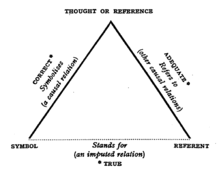Triangle of reference
This article has multiple issues. Please help improve it or discuss these issues on the talk page. (Learn how and when to remove these messages)
|

The triangle of reference (also known as the triangle of meaning[1] and the semiotic triangle) is a model of how linguistic symbols relate to the objects they represent. The triangle was published in The Meaning of Meaning (1923) by Charles Kay Ogden and I. A. Richards.[2] While often referred to as the "Ogden/Richards triangle", the idea was also expressed in 1810 by Bernard Bolzano, in his Beiträge zu einer begründeteren Darstellung der Mathematik. The triangle can be traced back to 4th century BC, in Aristotle's Peri Hermeneias. The Triangle relates to the problem of universals, a philosophical debate which split ancient and medieval philosophers, especially realists and nominalists.
The triangle describes a simplified form of relationship between the speaker as the subject, a concept as an object or referent, and its designation (sign, signans).
Interlocutory applications
[edit]Direction of fit
[edit]John Searle used the notion of "direction of fit" to create a taxonomy of illocutionary acts.[3][4]
This table possibly contains original research. (December 2012) |
|
|---|
The arrows indicate that there is something exchanged between the two parties in a feedback cycle, especially when the world is represented in both persons' minds and used for reality check.[editorializing]
See also
[edit]References
[edit]- ^ Colin Cherry (1957) On Human Communication
- ^ C. K. Ogden and I. A. Richards (1923) The Meaning of Meaning
- ^ John Searle (1975) "A Taxonomy of Illocutionary Acts", in: Gunderson, K. (ed.), Language, Mind, and Knowledge (Minneapolis: University of Minnesota Press) pp. 344-369.
- ^ John Searle (1976) "A Classification of Illocutionary Acts", Language in Society, Vol.5, pp. 1-24.
External links
[edit]- Jessica Erickstad (1998) Richards' Meaning of Meaning Theory. University of Colorado at Boulder.
- Allie Cahill (1998) "Proper Meaning Superstition" (I. A. Richards). University of Colorado at Boulder.
